
18th July (1969) in Dalit History – Death anniversary of Dalit writer – Annabhau Sathe
18th July (1969) in Dalit History – Death anniversary of Annabhau Sathe
Annabhau Sathe was a social reformer, folk poet, and Dalit writer from Maharashtra, India. Despite lacking formal education, Sathe wrote 35 novels in Marathi. He was a follower of Dr. Ambedkar’s teachings and Sathe’s stories were testaments to Dalit self-respect and resistance.
“Dalit writers are entailed with the responsibility of liberating and shielding Dalits from the existing worldly and Hindu tortures as the long standing conventional beliefs cannot be destroyed instantly.” – Annabhau Sathe
Anna Bhau Sathe was born in the village of Wategaon near Sangli district of Maharashtra in a family belonging to the Dalit Mang community. Poverty due to caste based discrimination had prevented Sathe from obtaining the formal education. His brother Shankarbhau recounts in his biography of Sathe, titled Majhe Bhau Annabhau, that the family members worked as laborers at the site of Kalyan tunnel when it was being constructed. Kalyan is in Thane district of Maharashtra.
Despite the lack of formal education, Sathe wrote in Marathi 35 novels, one among which was Fakira (1959). Fakira, which is currently in its 19th edition, received a state government award in 1961. There are 15 collections of Sathe’s short stories. A large number of his short stories have been translated into many Indian and as many as 27 non-Indian languages. Besides novels and short stories, Sathe wrote a play, a travelogue on Russia, 12 screenplays, and 10 ballads –powade (Marathi).
Sathe wrote directly from his experiences in life, and his novels celebrate the fighting spirit in their characters who work against all odds in life.
Lok Rajya, a Maharashtra state government fortnightly, published on 1 November 1993, had a special commemorative issue concerning Sathe. The state government also issued in 1998 a collection of his works under the title Lokshahir Annabhau Sathe Nivadak Sahitya.
To generate social awareness, Sathe organized stage performances of powade andtamasha, ethnic dances chiefly performed by women, which are popular in rural Maharashtra. He produced 14 tamasha shows. In the late 1940s, the then Home Minister of the Bombay state government Morarji Desai had banned tamasha shows, but Sathe courageously defied the ban by renaming them as lokanatya. People in Maharashtra conferred the epithet lok shahir on Sathe.
During the issue of a postage stamp of Anna Bhau Sathe at Chembur, Mumbai Minister Pramod Mahajan called Anna as a saint of Maharashtra. Sathe was an important mobilizer in the Samyukta Maharashtra movement. He used the medium of powade to great effect in that movement.Sathe was attracted to communism and had visited USSR. He was a founder member of the Lal Bawta Kalapathak of the Communist Party in Maharashtra.
Annabhau Sathe lived a life of destitution. After spending 22 years in a Ghatkopar slum of Mumbai, Sathe moved to a modest house in Goregaon which the state government provided him in 1968, one year before he died.
Read also –
अन्नाभाऊ साठे – एक भुला दिया गया हीरो, एक वाम-पंथी जो अम्बेडकरवादी बना



+ There are no comments
Add yours